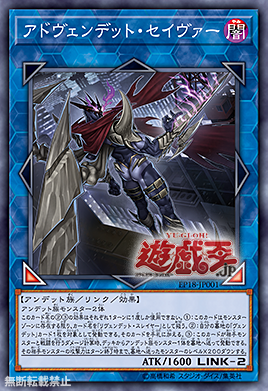 Vendread was a TCG-exclusive archetype consisting of DARK Zombie-Type monsters. The monster resembles creatures from the Resident Evil franchise. In fact, the archetype deliberately references Resident Evil in many occasions. The archetype first debuted in Code of the Duelist.
Vendread was a TCG-exclusive archetype consisting of DARK Zombie-Type monsters. The monster resembles creatures from the Resident Evil franchise. In fact, the archetype deliberately references Resident Evil in many occasions. The archetype first debuted in Code of the Duelist.
The archetype's main boss monsters have the prefix "re-" or "a-" in front of their names. The prefixes play on the word "Vendread" to create the word "revenge" and "avenge". This references the boss monster's (Revendread Slayer) desire for vengeance.
This article will look deeply into Vendread's lore, history and gimmick. It will also identify the competitive viability of this archetype.
Story Lore
Like most game-original archetypes, Vendread's cards tell a story. Here is the story/lore of Vendread.
(Note: This is my interpretation of the lore).
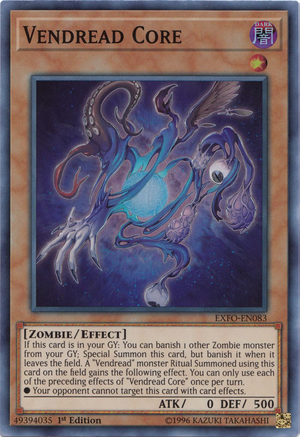 It's a typical day in the city until the apocalypse happened. The dead started rising from the grave. The cause of the reanimation is due to a mysterious sentient virus, 'Vendread Core'. The virus spread quickly, resurrecting the dead and controlling the living. It forced innocents to hide or risk dying and becoming one of them.
It's a typical day in the city until the apocalypse happened. The dead started rising from the grave. The cause of the reanimation is due to a mysterious sentient virus, 'Vendread Core'. The virus spread quickly, resurrecting the dead and controlling the living. It forced innocents to hide or risk dying and becoming one of them.
A couple is forced apart when the infection reached them. The loss of his love filled the man with the desire for vengeance. Reclaiming his sanity, he transformed into 'Revendread Slayer'. Driven by revenge, he fought the hordes of zombies and destroyed them. However, the hordes began to merge to form Vendread Chimera. Slayer fought against the chimera. The battle lasted a long time, but alas Slayer emerged victorious.
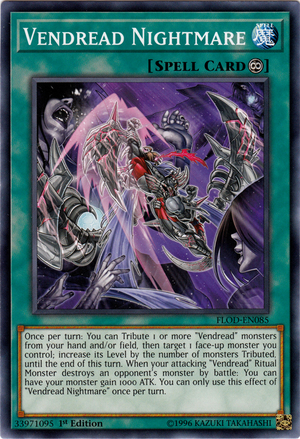 Suddenly, out of nowhere, an army of zombies appeared led by Vendread Battlelord. Driven with anger, Slayer fought against Battlelord, but was defeated. As Battlelord assimilated Slayer, his memories of his love reignited his vengeance. With one punch, he defeated Battlelord. The Core Virus emerged from the defeated Battlelord. It stole Slayer's pendant and took the form of his beloved (Vendread Anima). Filled with rage, Slayer transformed into Revendread Executor. Fearing for its life, Anima multiplied to escape, but was quickly struck down by Executor. This ended the entire virus outbreak.
Suddenly, out of nowhere, an army of zombies appeared led by Vendread Battlelord. Driven with anger, Slayer fought against Battlelord, but was defeated. As Battlelord assimilated Slayer, his memories of his love reignited his vengeance. With one punch, he defeated Battlelord. The Core Virus emerged from the defeated Battlelord. It stole Slayer's pendant and took the form of his beloved (Vendread Anima). Filled with rage, Slayer transformed into Revendread Executor. Fearing for its life, Anima multiplied to escape, but was quickly struck down by Executor. This ended the entire virus outbreak.
He avenged his love and his desire for vengeance is finally over. The sun is rising. Executor has grown weak. Will he finally find peace, or will he continue to scour the city to save those in need?
What Went Wrong?
When the archetype first debuted, players were hopeful and ecstatic. Some even claimed that they had the potential to be competitive. However, Vendread made little impact in the competitive scene once Konami revealed all the support. What went wrong with the archetype? How did it go from "it has potential" to "trash"?
Off to a Great Start
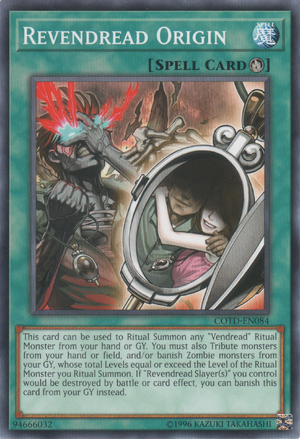 Vendread debuted in 'Code of the Duelist' with five cards. Revendread Slayer is not exciting. Vendread Reorigin isn't incredible, but it was decent non-destruction removal. What amazed the players were the monsters, Vendread Revenants and Houndhorde, and the Ritual Spell, Revendread Origin.
Vendread debuted in 'Code of the Duelist' with five cards. Revendread Slayer is not exciting. Vendread Reorigin isn't incredible, but it was decent non-destruction removal. What amazed the players were the monsters, Vendread Revenants and Houndhorde, and the Ritual Spell, Revendread Origin.
These three cards illustrated the core gimmick of this archetype which is to powerup the ritual monster by tributing the smaller monsters. Revenants and Houndhorde give the ritual monsters a powerful quick once per turn banishing effect. Revendread Origin is an efficient Ritual Spell card. It can Ritual Summon monsters from the Graveyard as well as using materials from the grave. Players are also allowed to tribute monsters to exceed the total level of the ritual monster. The best of all is that Pre-Preparation of the Rite can search this card.
From the first wave, things were looking great for Vendread. They had their core gameplay laid out in the first wave. It's no surprise that many players were getting hyped for this deck. All they needed was a consistent way to get a powerup Slayer onto the field.

Disappointing Second Wave
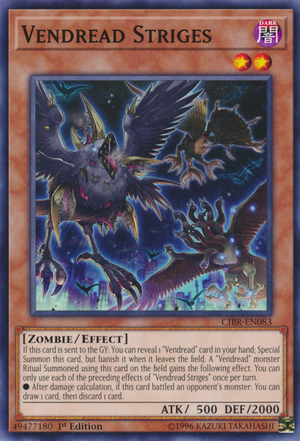 Things started to look bleak for Vendread in the second wave. We didn't get any cards that would help the archetype, nor any cards that changedr the way they played. Vendread needed a Ritual Spell searcher. It also needed a faster way to dump Houndhorde and Revenants to the field. We didn't get any of that.
Things started to look bleak for Vendread in the second wave. We didn't get any cards that would help the archetype, nor any cards that changedr the way they played. Vendread needed a Ritual Spell searcher. It also needed a faster way to dump Houndhorde and Revenants to the field. We didn't get any of that.
We got a mediocre Ritual Monster (Vendread Chimera) that isn't worth using. Striges' "inheriting" effect is non-impactful. Its awkward level makes it practically unusable in 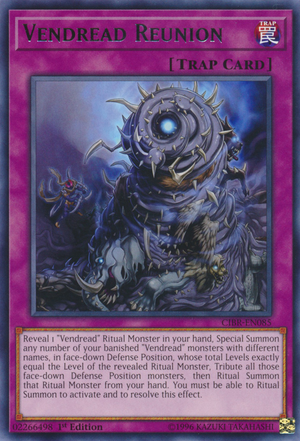 the deck. The Field Spell, Vendread Nights, is a searcher that should've also searched Trap/Spell cards. I mean it's a Ritual Deck, it needs all the consistency it can get. Vendread Reunion is just straight garbage. It's technically the archetype's second "Ritual Spell" except it's a trap. It's unsearchable, slow, and requires an insane amount of setup. What's worse is that the card would barely resolve due to the monsters' awkward levels. All the cards in this wave felt like "filler cards".
the deck. The Field Spell, Vendread Nights, is a searcher that should've also searched Trap/Spell cards. I mean it's a Ritual Deck, it needs all the consistency it can get. Vendread Reunion is just straight garbage. It's technically the archetype's second "Ritual Spell" except it's a trap. It's unsearchable, slow, and requires an insane amount of setup. What's worse is that the card would barely resolve due to the monsters' awkward levels. All the cards in this wave felt like "filler cards".
From this wave, many fans began to worry about this archetype's future. However, fans were hopeful that Konami could salvage Vendread.
Lingering Hope
 In the third wave, things started to improve for Vendread slowly. However, fans were still not ecstatic with the support in this wave.
In the third wave, things started to improve for Vendread slowly. However, fans were still not ecstatic with the support in this wave.
Vendread Battlelord is an okay monster, but its effect is practically useless against monsters or spells. The only time this effect works is during the battle phase when used against traps. Vendread Core is a good monster. It summons itself and prevents from the Ritual from getting targeted by card effects. However, it's awkward low level killed its usability. Vendread Charge is a great card. It's a shame that it has the discarding a card cost. Vendread Revolution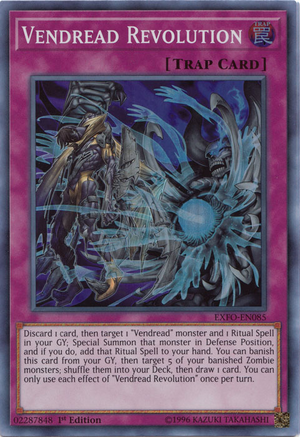 is just terrible. It's a slow convoluted Ritual Monster and Spell recovery. Its second effect is oddly specific for a modern era deck.
is just terrible. It's a slow convoluted Ritual Monster and Spell recovery. Its second effect is oddly specific for a modern era deck.
Vendread fans considered this support passable but not needed. Besides Charge, it doesn't address Vendread's consistency and speed problem. This support made clear to players that Konami has no direction for this archetype. At this point, many players had lost all hope for Vendreads. Many refer Vendread as the archetype with a potential that was never delivered. However, some still had a lingering hope that the final wave would save the archetype.
No Hope
Any hope was lost in this final wave of support. The support in this wave is generally decent, but unfortunately doesn't do enough.
We finally got a Ritual Spell searcher. However, it's in the form of a Ritual Monster, Revendread Executor. You got that right! Konami wants the player to Ritual Summon first to search for the Ritual Spell. To be fair, Executor allows the player to search for any Vendread card. Executor is an okay card, but it doesn't really do anything. Vendread Anima's banished monster recovery is decent. However, its inheritable effect is useless.

Revendread Evolution did one right thing, which is to use material from the Deck. However, it did everything else wrong. It should've summoned the materials first so that the ritual could inherit the materials' effects. Furthermore, the destruction of the ritual monster hurt this card. Vendread Nightmare is straight-up garbage. This card makes no sense. Why would I discard monsters to increase a monster's level by one? Why does my monster only gain 1000 ATK after it destroys a monster? Vendread Daybreak isn't bad, but I have no idea why it doesn't allow the player to attack. The archetype is already situational and inconsistent. Allowing the player to attack wouldn't break the archetype.
This final wave officially killed any hope for this archetype.
New Hope
 When Konami confirmed an OCG-exclusive card for Vendread, several fans were hopeful that the card would fix Vendread. Many of those players pointed to how OCG-exclusive Double Helix broke Spyral. However, other players were not as optimistic. They claimed that Spyral had a perfectly functioning engine way before Double Helix. Furthermore, those same players also said that what broke Spyral was MR4 and Link Monsters.
When Konami confirmed an OCG-exclusive card for Vendread, several fans were hopeful that the card would fix Vendread. Many of those players pointed to how OCG-exclusive Double Helix broke Spyral. However, other players were not as optimistic. They claimed that Spyral had a perfectly functioning engine way before Double Helix. Furthermore, those same players also said that what broke Spyral was MR4 and Link Monsters.
In 2018, Konami released Avendread Savior. It’s a good card but doesn’t solve any of the inherent problems. With that, all hope is officially gone. The archetype started with excellent support. But all support that came after led the archetype to nowhere. Due to this, players often refer to Vendread as the archetype that never lived up to its potential.
Was There Any Potential?
As mentioned earlier, players claimed Vendread failed to live up to its potential. However, looking back at the core mechanic of the archetype, it got me thinking. Did it have any potential? Looking at the first wave of support, I believe the archetype was doomed to failure from the start. The team who designed Vendread have no idea about Rituals and the current meta.
Synchro Playstyle
Vendread is an archetype that focuses on swarming the field with monsters to perform a Ritual Summon. Players can Ritual Summon using materials from their hand, but they will end up with a vanilla monster. Therefore, players are encouraged to summon the fodder first. This concept isn't inherently bad. Many meta decks use this playstyle where they swarm the field to summon an Extra Deck monster. However, this type of playstyle doesn't work for Rituals. Rituals need searching to be playable. Swarming the field doesn't do anything when the player can't perform a Ritual Summon. Furthermore, Rituals have the advantage of not having to summon the fodder to Ritual Summon normally. Taking away that advantage and still requiring a Ritual Spell and monster in hand makes them an inferior 'synchro' deck.

This core gameplay alone shows that Vendread had no potential from the beginning. Taking away ritual's only advantage is just bad. It honestly feels like the team designing Vendread had no idea how Rituals worked. Vendread is a Ritual Deck that plays like a Synchro Deck, but without the power of a Synchro Deck.
High Cost
Another major problem with Vendread is its high cost. Many cards in Vendread requires the player to discard a card to activate a mediocre effect. This problem existed in the first support wave in Vendread Houndhorde. Usually, this isn't a problem in Synchro Decks. This is because they have many cards that allow them to recover the discarded cards (e.g. Hyper Librarian). However, this is a massive issue in Vendread due to two reasons. First, Vendread has no way of recovering its resource besides Savior. Second, Vendread is a Ritual archetype. The ritual mechanic inherently goes minus. Forcing players to discard cards regularly is a death sentence in Ritual Decks.

Due to this, it's clear that Vendread had no potential from the beginning. The archetype minuses itself way too much. They also have no way to recover if their opponent wipes their board.
Awkward Levels
The Ritual Mechanic tends to go minus. How do modern Ritual Decks address this issue? They usually have high-level fodder so the players wouldn't need to tribute more than one or two cards to Ritual Summon. Vendread again ignored this. From the get-go, we had two great monsters, 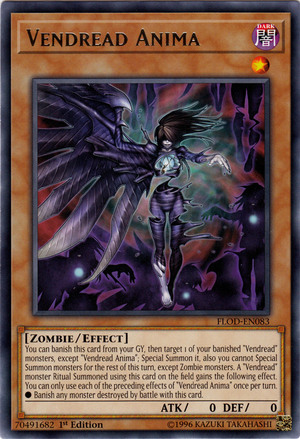 Revenants and Houndhorde. They were Level 4 and 3. Pretty respectable levels. After that, we got a Level 2 Striges, a Level 1 Core and then a Level 1 Anima? The low levels mean the player needs to Tribute more monsters than necessary. Furthermore, the low levels also cause bricking since you're more likely not to have enough materials to tribute.
Revenants and Houndhorde. They were Level 4 and 3. Pretty respectable levels. After that, we got a Level 2 Striges, a Level 1 Core and then a Level 1 Anima? The low levels mean the player needs to Tribute more monsters than necessary. Furthermore, the low levels also cause bricking since you're more likely not to have enough materials to tribute.
The release of the Level 8 Executor practically forces the player to Tribute even more monsters. You want to have an Executor that banishes spell/trap and monsters? Well, you also need to tribute a Level 1 monster as well now.
This demonstrates the lack of potential the archetype has. A Ritual Deck wants to spend as little materials as they can to Ritual Summon, not spend more.
Pebble Ruling
There's a ruling known as the "Pebble Ruling". What it says is you can never Tribute extra materials if you've already satisfied the level requirement. For example, if I want to Ritual Summon Lv6 Slayer and I have already Tributed the necessary amount (e.g. Lv 3 + Lv 4), I cannot Tribute more materials. This is because I have already tributed the required amount. Therefore it's impossible to have a Ritual Monster with ALL the inheritable effects. However, the archetype supports push the players for this gameplay.
The TCG Team failed to take into account the pebble ruling when designing this archetype. This demonstrated the archetype lacked any potential.
Failed Gimmick
Believe it or not, this isn't Konami's first attempt of the "inheritable effects"  gimmick. They first tried this gimmick with Black Luster Rituals. It failed miserably. A few years later, they tried again with Vendread. It failed again. Funny enough, they then tried this gimmick again with Ruin/Demise which also failed miserably.
gimmick. They first tried this gimmick with Black Luster Rituals. It failed miserably. A few years later, they tried again with Vendread. It failed again. Funny enough, they then tried this gimmick again with Ruin/Demise which also failed miserably.
What makes this gimmick so bad? It's because it shapes the building of the Deck. You can play the Deck without the fodders, but the Rituals will basically end up as a vanilla monster. It basically forces the player to always add the specific fodders no matter how bad they are. For example, Vendread Revenants itself is a terrible card, but its inheritable effect is crucial for the ritual. Not adding it means you're taking away a potent effect from your Vendread Ritual Deck. The gimmick also makes the Deck extremely predictable and even more inconsistent.
 The gimmick also clashes with other Ritual supports. Take Impcantation, for example. Vendread directly clashes with Impcanation due to its gimmick. You can still use the Impcantation monsters to search out the ritual cards, but don't think about Tributing them. Then again, Impcantation practically forces Vendread players not to use Avendread Savior.
The gimmick also clashes with other Ritual supports. Take Impcantation, for example. Vendread directly clashes with Impcanation due to its gimmick. You can still use the Impcantation monsters to search out the ritual cards, but don't think about Tributing them. Then again, Impcantation practically forces Vendread players not to use Avendread Savior.
This shows that they honestly had no potential from the beginning. Archetypes with this gimmick have demonstrated time and time again that it doesn't work. This is due to the consistent trait where Konami deliberately make the boss monster vanilla to compensate the fact that you COULD power it up.
Battle Oriented Effects
Another problem with Vendread is the number of battle orientated effects. From the get-go, the main boss monster's effect is a beat stick. All the ritual monsters that came are the same. Furthermore, Striges and Anima's inheritable effects are also battled focused. The significant emphasis on battle orientated effects shows the archetype had no potential. The sad thing is that combat-focused archetypes just doesn't work in this era unless they can OTK.
What Did It Do Well?
They're pretty good at Ritual Summoning if you ignore the powering up gameplay. Revendread Origin is a very productive card. It's very easy for players to Ritual Summon a monster quickly. Furthermore, the Deck is also extremely good at discarding the entire hand to the grave. Maybe there is a gimmicky build out there. Who knows? Ironically, they were also quite decent in making an Extra Link board due to Firewall Dragon.

Are They Salvageable?
For this archetype to be good, Konami needs to create support that focuses on getting both Revenants and Houndhorde on the field quickly. They'll also need to give them an easy Ritual Spell searcher. Furthermore, Vendread needs ways to recover from all the minuses other than Avendread Savior. That or Konami can abandon the Ritual route and focus on Extra Linking. However, MR2020 made Extra Linking less threatening, so I doubt they'll leave a mark in the meta.
Conclusion
Vendread is an interesting archetype. It was a Ritual Archetype that didn't take advantage of the MR4 rulings. When it first debuted, the archetype excited players. However, continuous inadequate support, combined with a terrible gimmick, has killed the Deck. Hey, at least the deck is fun, and the art is beautiful.





